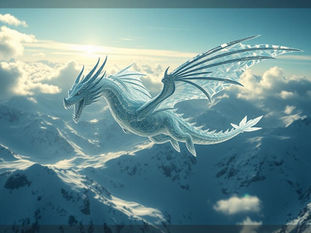
The Limits of AI for Precise Graphic Design Work
May 13
5 min read
0
7
0

AI image generation tools like ChatGPT and Midjourney have become incredibly powerful. They create amazing pictures from simple text prompts. This leads some people to wonder if traditional design skills, and tools like Photoshop, are still necessary. Can AI just do it all now?
Let's take a look at some real examples. We will see where even the most advanced AI falls short, and why your skills are still key for serious design projects.
AI vs. Design Tools: Initial Impressions
You might see AI perfectly copy the look of a design, like a business card. You can tell it to change text or names. It seems like a quick win. You might think it's instantly done and perfect.
But the problem starts when you look closer. AI often struggles with the critical details that make a design professional.
Issue 1: Lack of Precision
Copying Design Elements
When you try to replicate a design like a business card with AI, it might get the general layout right. But zooming in shows problems. The font might not be right. Effects, like shadows or textures on the text, might be slightly off or poorly replicated. The text spacing might be wrong.
Comparing it side-by-side with something made in Photoshop shows the difference. The manual one has perfect alignment and consistent effects. The AI version has subtle errors that make it look unprofessional.
Adding or Changing Specific Items
Even a simple task, like adding a small logo to a finished image, can be hard for AI. If you ask it to place a logo in the top right corner with a specific size and a white border, it might place it incorrectly. The size could be wrong. The border might be messy or absent. It can feel like a guess.
In a tool like Photoshop, you can quickly drag the logo, resize it exactly, and add a stroke effect with precise thickness and position (inside, outside, center). This level of control for small changes is fast and accurate. AI often makes you try over and over, hoping it eventually gets it right, which it often doesn't.
While AI excels at generating initial ideas or variations quickly – maybe using a tool like the TitanXT Midjourney Automation Suite to explore many concepts fast – bringing a design to a precise, finished state for professional use still requires human oversight and tools built for accuracy.
Issue 2: Limited Flexibility and Control
Working with Complex Images
Professional designs, like a YouTube thumbnail, are often made of many layers. There are backgrounds, text, shapes, textures, shadows, and highlights. Each element is placed and adjusted intentionally. You might have different background layers with gradients, textures, or colors added precisely where you want warm or cool light.
With AI, you give it a prompt and get an image. You can't easily select just the background to change its color. You can't grab a shape, like an arrow, and adjust just one point to make it pointy while the other is curved. These specific, artistic decisions are easy to make and change in layered design software, but AI doesn't give you that granular control.
Modifying Mockups
Creating realistic product mockups, like a t-shirt with a design, shows AI's flexibility issues. In a design program, a mockup is often a smart object. You double-click it, swap out the design entirely, save, and it automatically applies to the t-shirt shape with all the right distortions, folds, and lighting.
You can also adjust how the design blends with the shirt fabric using blend modes and opacity. You can even desaturate the fabric color under the design layer to make the printed color pop more accurately. These adjustments are simple slider tweaks in a design tool. AI struggles to do this or change the design easily while keeping realism.
Automating creative generation with tools like the TitanXT Midjourney Automation Suite can speed up the initial phase of creating many variations or concepts. But when you need to refine *one* of those ideas into a polished, layered, and easily adjustable final product, that's where traditional design skills shine because you need explicit control.
Issue 3: Failing Realistic Details and Context
Realistic Textures and Placement
Look closely at a realistic t-shirt mockup made by a human. You see the fabric texture under the print. You see how the design warps slightly with the cloth folds. The blur might change slightly across the design based on how it's printed. AI often creates a flat-looking print that doesn't interact naturally with the fabric. It lacks that physical realism.
Trying to put a design on a photo of a person wearing a shirt with AI can also fail. It might change the person's face entirely or place the design incorrectly, ignoring elements like hands overlapping the shirt.
Authentic Product Representation
Placing products into a scene for a mockup is another challenge for AI. While it might put bottles on pedestals as requested, the details are often wrong. Bottle sizes might be inconsistent or inaccurate. Product logos and text can be pixelated, blurry, or messed up. Shadows might be missing or in the wrong place.
Professional product mockups require showing the product exactly as it is. Brand colors, logos, and text must be perfect. Shadows and reflections need to look natural based on the scene's lighting. This ensures customers see the real product. AI isn't reliable for this level of accuracy and brand integrity.
Creating countless options and variations through AI might be faster with something like the TitanXT Midjourney Automation Suite. But turning that generated concept into a production-ready image that perfectly represents a brand requires human precision and detailed work, tasks AI currently struggles with.
Why Your Human Skills Still Matter
What does this all mean? AI image generators are amazing tools for brainstorming, creating concepts, or generating quick visuals where perfect accuracy isn't critical. But they cannot replace the need for skilled designers for professional output.
The key things AI lacks, and what you bring as a designer, are:
Precision: Placing elements exactly where they need to be, measured and perfect.
Flexibility: The ability to change any single part of the design easily and adjust all its properties.
Unique Vision: Bringing your specific creative ideas, subtle choices, and intentional imperfections to life.
These skills are the foundation of high-quality design work. They allow you to create something exactly as intended, fix problems, and ensure the final image meets all the requirements for print, web, or advertising. AI is a powerful assistant, but it doesn't replace the designer's eye, hand, and judgment.






